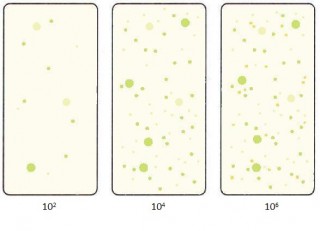WHAT ARE DIPSLIDES?

PDM Comparison Chart |
WHAT IS A DIPSLIDE? The definition of a dip slide, as described in the HSE approved code of practice and guidance for the control of legionella bacteria in water systems, is a means of testing the microbial content of liquids. It consists of a plastic carrier bearing a sterile culture medium which can be dipped in the liquid to be sampled. It is then incubated to allow microbial growth. The resulting microbial colonies are estimated by reference to a chart. |
|
Dipslides are the most common method of measuring and monitoring microbial activity within many systems and commonly cooling systems. DTK dipslides are supplied in boxes of 10 and come complete with instructions and a colour count chart which is used to determine the concentration of aerobic activity. DIPSLIDE(S) The HSE’s ACoP L8 recommends the use of dipslides to monitor the general activity of aerobic bacteria. All dip slides should be incubated at 30oC for 48 hours to obtain a true result. Dip Slides are commonly used for the detection of slime forming bacteria in cooling & industrial water systems. DTK dipslides are dipped into the water sample and incubated for 48 hours. Any bacteria in the sample water will grow and form colonies. When compared with the reference chart supplied on the dip-slide box it is possible determine the number of bacteria in the sample. Once the dipslide has been placed in contact with the sample water or surface it should be returned and secured in its container for incubation for 48 hours normally 30oC. For continuity it is important to ensure that the incubation period and temperature is consistent each time the test is performed. For mobile users DTK offer a 12V/240V dual voltage incubator. Cooling tower water should be be tested using dipslides on a weekly basis. The consistency of timing when microbiological testing is important and the sample should not be taken if biocide has recently been applied. The clarity of the sample is not indicative of bacteriological activity and the test should be carried out regardless of sample clarity. If the treatment programme is effective, the dipslide counts should be consistently low (<104). If an unusually high result is obtained, the test should be repeated as soon as possible and confirmed. Once confirmed appropriate corrective action should be taken. Go Back to view our full dipslide range. |
|






